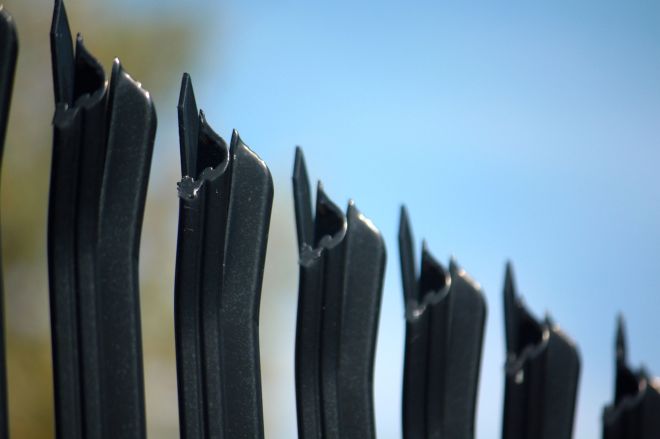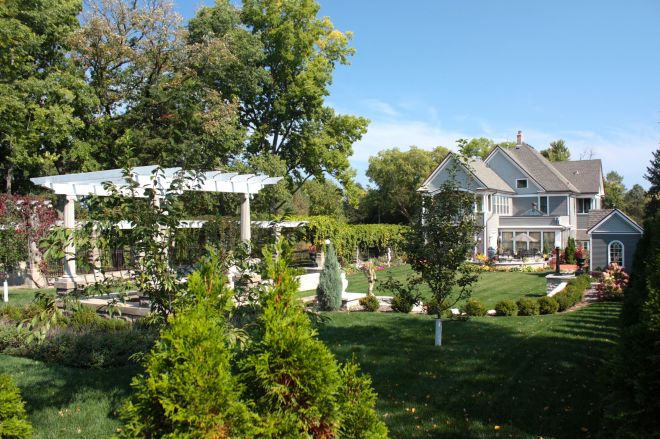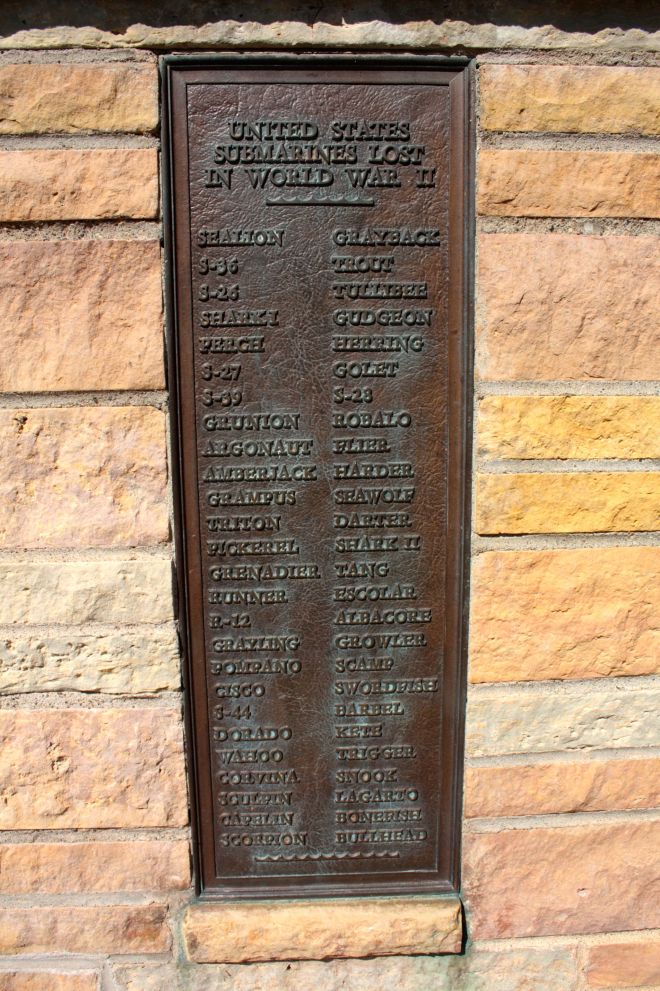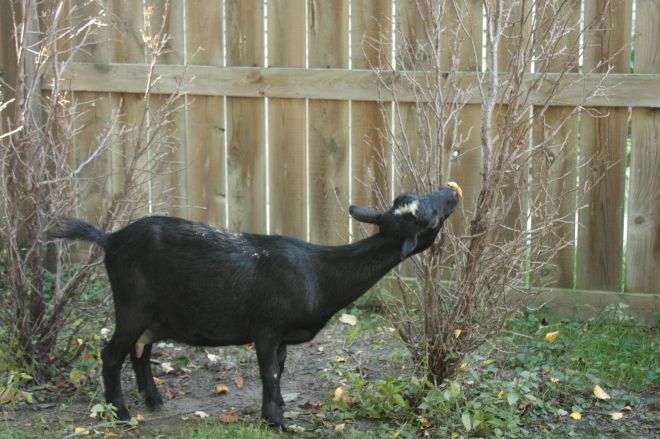Saturday, September 27, 2014
Frogtown, Como, Highland Park
The stunning September weather continued for another weekend, bringing enough sun and warmth to almost blot out thoughts of putting my bike away for the season. The points of interest started in Frogtown with the Church of Saint Columba, the iconic Catholic church on Lafond Street. I usually favor the architecture of older, traditional churches but the design and construction of Saint Columba are superb. The distinctive cylindrical spire topped with a silver cross seems to keep watch over the neighborhood. Although not apparent from the ground, Saint Columba is shaped much like a fish.(1) The more you look, the more you see all that makes this church so special.
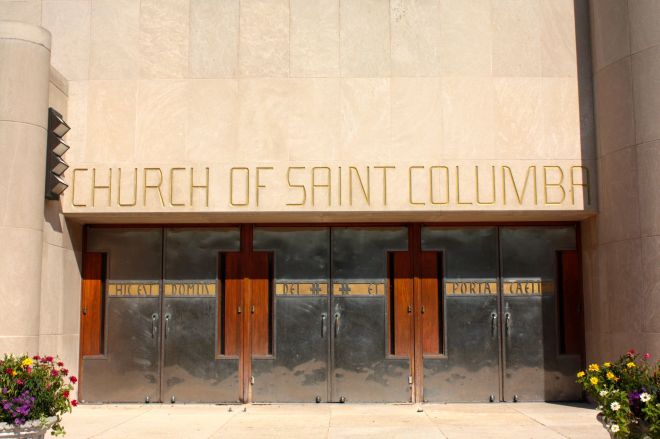
The steel doors and above them, the stunning gold lettering are strongly set off by the white stone of the building.
I did not go into Saint Columba but all accounts and photos I’ve seen indicate the unique architecture and beauty continue inside.
If you are unhappy with your internet speed (who isn’t?) and concerned about your safety and security and that of your belongings, this building is perfect for you. Officially known as “St. Paul STP-1125 Data Center”, the 113,000 square foot building includes multiple fiber optic providers (super fast Internet!), a large conferencing room, large fitness center next to showers and lockers, office and warehouse space.(3) Not only that, there are as many as 60 indoor parking spots, so there’s more than enough room for you, your family and one hundred of your closest friends or family.
Most recently the building housed a MISO (Midcontinent Independent System Operator) data center, an independent, not-for-profit regional transmission organization responsible for maintaining reliable transmission of power in 15 U.S. states and one Canadian province.(4)

A peek between the fencing shows two large, semi-mounted generators ready in case the power goes. Never again will a pesky thunderstorm interrupt your Internet surfing or Netflix.
Churchill Street, a one-way thoroughfare very near Como Park and Como Lake features some beautiful homes. The largest, which I would call an estate, faces east so the backyard is on Churchill and the house is on Como Boulevard, facing east. The extraordinarily sculpted landscaping and backyard structures made me feel as if I were transported back to the Victorian Era. The home, built in 1902, is known as the Karl Wessel residence.

A long-standing wrought iron fence beautifies the neighborhood and discourages uninvited guests from enjoying the back yard.
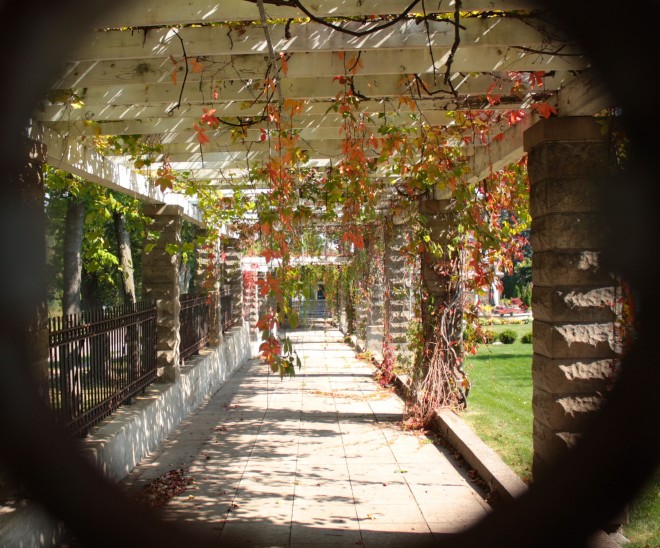
Peeking through a decorative wrought iron circle on the fence I got an unusual view of the sidewalk between the house and the back yard. The vines hanging on a large pergola confirm it’s autumn.
Before I moved on to the front of the Wessel House, I turned to the north and took a few steps across Churchill Street, just into Como Park, to examine an unconventional memorial.

The torpedo was donated by the U.S. Submarine Veterans of World War II in 1965 as a remembrance of those who died aboard subs during that war.(5) A plaque on one side of the memorial lists all who died aboard the USS Swordfish. The other plaque names the 52 U.S. subs lost during World War II.
The distinctive wrap-around porch and a turret, the two most interesting features of the Wessel House, came into view as I got close to the front.

The freshly remodeled Karl Wessel House looks very much the same from the front as it did in 1905, about three years after being built for $10,000.
Karl Wessel was an inventor on top of being an architect. His more intriguing inventions include 1902’s “Mattress-Filling Machine”, a “Briquet Machine” from 1906, and two years later, a “Machine for Making Ice Cream Cones.”
There are close to a dozen Victorian-era homes along Como Boulevard. While none are bigger than the Wessel House, nearly all have been restored to their original glory, or at least updated.
In the 1880s, 52 acres of land in this area made up the railroad suburb of Warrendale. One of the developers, Cary I. Warren, lived at 1265 West Como Boulevard.
On a number of rides I’ve come across someone worthy of a story and interview but the resident or business owner isn’t available. Occasionally I’ve visited two or three times with no luck, so in those cases I’ll make an appointment. That’s the situation today; I have an appointment in Highland Park, so I’m off to Lexington Parkway to go south.

Central Lutheran School, formed by the merger of several Lutheran schools, opened here in 1951. A predecessor school goes back to 1861, just after Minnesota became a state.(7)
.
Continuing southward on Lexington, I stopped for a red light at Thomas Avenue. There, in a bucket truck some 20 feet above the street, stood a painter putting a new coat of paint on the stoplight.
After a few minutes Kerry Koenker finished one light and pole and moved his truck to the east side of the intersection. The first question I asked Kerry was how he likes painting traffic signals for a living. “I love what I do! I get to be outside. I work hard so I stay in pretty decent shape. The money’s real good.”
Kerry has been a “vested union journeyman aerial industrial painter” (that’s his official title) for 25 years. He’s worked for Aerial Painting Inc. for all but about two of those years.
I was surprised to learn that Kerry spent four years at Saint Paul Technical College learning the trade. “Then after the four years you also have to work 6,000 hours to work your way up to journeyman (pay) scale, which is the highest scale.”
Kerry told me it takes him about seven hours to prep and paint one traffic signal like these at Lexington and Thomas. “First of all, we’ll pressure wash the poles and then prime them and then you gotta paint them. We’ll paint the stanchions (vertical post), the heads (stoplight), the pipes, the mast arm, the illuminator, the bases and the buttons. We’ll paint them all.”
When I asked Kerry whether painting traffic lights is dangerous, he answered with a quick and firm, “Very. When we go to do the mast arms we have to literally park in the middle of this busy road; because wherever there are lights, that means inherently it’s busy. So I have to park on the main drag there (Lexington) and then you also have a good chance of being rear-ended.”

Kerry works on the traffic light overhanging Lexington. The only place he can park the bucket truck is in the street.
I’ll be right here working on that side of the pole and the traffic comes by and if they’re not careful and I’m not careful, I’m dead.” Kerry Koenker
Kerry told me about his closest call, which came about when he was painting lights on a freeway exit. A man in a large van drove between Kerry’s truck and a pole Kerry was painting. The van glanced off Kerry’s truck and the pole and crashed. “When the cop came, he’s here talking to me and I said, ‘Do you think if that van had rear-ended me it would have killed me?’ And he says, ‘No, I don’t think it would have killed you, I know it would.’”
“It was surreal. I couldn’t believe how lucky I was not to be killed.”
Kerry found out later the driver of the van lost control of the vehicle because he suffered a heart attack.
Aerial Painting Inc. is one of the very few companies in the Metro area doing this specialized painting, so Kerry and his bucket truck are occupied spring to fall.
My unexpected and captivating visit with Kerry put me about 40 minutes late for my appointment in Highland. Shortly before 3 p.m. I arrived at Luke and Hal’s.
The sound of a barking dog is common; the occasional cat’s meow routine; a chicken cluck infrequent; and most never hear the bleat of goats in Saint Paul–unless you’re near the intersection of Lexington and Juno Street. Lucas (Luke) Clapp and his dad, Hal, have been raising Nigerian Dwarf goats in their backyard at 1086 Juno Avenue for about a year and a half. Charlotte and Luna are both females that the Clapps bought from a breeder in Orr, Minnesota.

Lucas (Luke) Clapp, left, pets Luna and holds a container of goat milk. On the right, Luke’s dad Hal, holds onto Charlotte.
“Of course they were in the house for a while with the kids and on the sofas…” Hal said. The goats moved out of the house as soon as Hal built them a barn.
According to Hal, “What really got us started was Lucas being involved in Future Farmers of America with Highland (Park) High. It’s pretty unique for a metro school to have that program, but they’ve had it for quite some time.”
Prior to the goats, the Clapps had chickens and bees, so unusual pets is normal for them.
Believe it or not, goats and many other hoofed animals are legal to keep in Saint Paul and according to Hal, it’s easy to get the necessary permit, “The City of Saint Paul is pretty flexible on that as long as you have the neighbors’ permission and you’ve got the right sort of space for the animals.”
Charlotte and Luna are energetic but the Clapp’s backyard has mellowed significantly since spring when Charlotte and Luna gave birth to five kids between them. Luke and Hal sold the kids through an ad on Craigslist.
The does are more than pets. “One of the things that we said, and he (Luke) agrees with, is if we’re going to have animals they’re going to have to produce something,” Hal told me. “So we have two beehives, the chickens and the goats and I have goat milk in the refrigerator right now.” Hal said he’s about ready to take his first shot at making chèvre (French for goat cheese).
“People come over all the time; you’ll hear them; they’ll be like, ‘I thought I heard goats!’ ‘Yeah, yeah, you did’.” Hal Clapp on what he overhears people in the parking lot of the nearby Trader Joe’s say.
I asked Luke whether the goats are social. “I didn’t realize how much of a personality they would have and how much they’re like dogs in a lot of ways. They really like people. I thought it would take some training to get them to like people. At first they were a little skittish but almost immediately they warm up to you a lot.”
Luke told me that like a dog, he tried to take Luna and Charlotte for walks a few times. “One time I had them on a leash and I let them off ‘cause I thought, ‘OK, they’re interested in food.’ They turned around and just sprinted across Lexington and just right home. They wanted to be back.”
Hal mentioned that each goat has a unique personality. “This one (Charlotte) is super, super headstrong and really smart. When I get them on the milking stand and Luna will jump right up and Charlotte will be, ‘I know where this is going. I don’t care how hungry I’m not going up there.’”
According to Hal, the goats enjoy the backyard. “They’re kind of free range; they’ve been pretty good about staying in their pen but they get kind of noisy and they like to be out. They’ll lounge around in these chairs. They will eat anything they want to, pretty much. So I used to have a pretty nice flower garden back in here around the rain garden…”
I figure the missing leaves on the shrubs and hedges were the result of two hungry goats, not the autumn weather.
Footnotes
(1) Church of Saint Columba website, http://turnerscross.com/architecture/barry-byrne/church-of-st-columba-st-paul-minnesota-1949/
(2) Franciscan Brothers of Peace website, http://www.brothersofpeace.org/index.php/faq-sp-442588529
(3) CBRE Digital Realty website, http://www.cbre.us/o/minneapolis/AssetLibrary/1125EnergyParkDrive_InteractiveBrochure_v03_SH%5B3%5D.pdf
(4) MISO website, https://www.misoenergy.org/AboutUs/Pages/MISOFAQ.aspx
(5) Como Park History Tour: Part 1, page 2 http://www.district10comopark.org/uploads/Como+Park+History+Tour+Short+Version+for+D10_2.pdf
(6) The Improvement Bulletin, Oct. 11, 1902, page 15
(7) Central Lutheran School website, http://www.clssp.org/history.cfm









